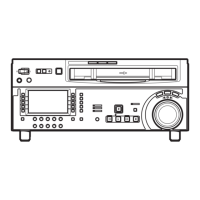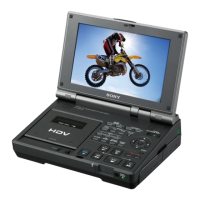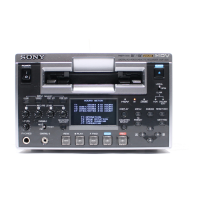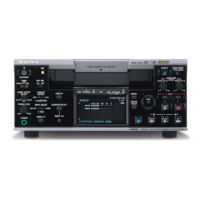Do you have a question about the Sony HDWM2000/20 and is the answer not in the manual?
Provides essential safety warnings for preventing fire and electrical shock hazards in multiple languages.
Details FCC regulations for Class A digital devices, addressing potential radio interference.
Describes the HDCAM format, tape specifications, and high-performance heads for reliable recording.
Details the HD 4:2:2 component video processing, interfaces, and high-quality four-channel audio.
Explains the optional SDTI input/output capability for transferring HDCAM data and metadata.
Highlights the compact 4U design with a comprehensive front panel for wide-ranging functions.
Covers basic buttons, jog/shuttle dial, time data display, and menu-based control interface.
Details various playback modes, editing functions like DMC, split, preread, and cross-fade.
Describes downward/upward conversion functions and Tele-File capabilities for data management.
Explains control via RS-422A serial and parallel interfaces for external device integration.
Details mounting the unit in a standard EIA 19-inch rack using an optional adaptor.
Identifies the three main control panels: Upper, Lower, and Switch panels.
Details the POWER switch, REMOTE/RS-232C indicators, EJECT button, Format indicators, and PHONES jack.
Covers audio controls, indicators, time/menu display, MULTI CONTROL knob, and RESET button.
Details REC INHI, Tape Transport, Editing Mode, ALARM/KEY INHI, Editing Control, Shot Mark, and Player/Recorder controls.
Explains input signal selection, display modes (FULL/FINE), and audio setting display.
Describes buttons for selecting audio signals for monitoring.
Details time data display areas, indicators for time code, format, and system frequency.
Explains the menu display section for function and setup menu operations.
Describes operations for shuttle, jog, and variable speed playback using the search dial.
Explains the REC INHI indicator logic based on function menu and cassette settings.
Details functions of PREROLL, REC, EDIT, STANDBY, STOP, F FWD, PLAY, SERVO, and REW buttons.
Covers DMC EDIT, MEMORY, DELETE, TRIM buttons for editing operations.
Details edit point setting, PREVIEW, REVIEW, and AUTO EDIT buttons for editing workflow.
Describes LIST, REC/ERASE indicator, and MARK buttons for shot mark management.
Details usage of memory card and memory stick slots for firmware and settings.
Explains CONTROL PANEL connector, PANEL SELECT switch, and KEY INHI switch functions.
Describes AUDIO INPUT connectors (XLR) and their associated level setting switches.
Details AUDIO OUTPUT connectors (XLR) and CUE IN/OUT connectors.
Covers REF. VIDEO INPUT connectors and analog video output connectors.
Details AES/EBU digital audio input and output connectors.
Describes HDSDI, SDTI, and SDI input/output connectors for digital signals.
Details remote control connectors including parallel, serial, and video control interfaces.
Describes connectors for inputting and outputting time code signals.
Illustrates connections for inputting serial digital signals from other digital VTRs.
Explains how reference signal selection adapts to menu settings and operational status.
Describes the organization of basic and extended setup menus for unit configuration.
Details how to adjust character display position, size, and type using setup menu items.
Explains the types of time data and information displayed on the monitor.
Lists supported HDCAM cassette types and other compatible formats for playback.
Provides instructions for inserting, ejecting, and removing tape slack from cassettes.
Covers Memory Stick insertion, removal, types, MagicGate, and important usage precautions.
Details necessary switch and menu settings before initiating recording.
Details necessary switch and menu settings prior to commencing playback.
Covers time data selection, normal playback, and various playback modes like Jog, Shuttle, Variable, DMC.
Explains DMC playback functionality, variable speed control, and tape movement during the process.
Details the procedure for storing variable playback speeds in memory for DMC playback.
Explains Assemble/Insert editing modes, CTL time code interpolation, and time code recording.
Outlines the sequence of editing operations and usage of editing control units.
Details the necessary switch and menu settings for both recorder and player during editing.
Describes how to set IN and OUT points for video and audio edit points.
Explains automatic setting of edit points, including conditions for failure.
Provides procedures for modifying edit points using TRIM and deleting points.
Details steps for cuing up to edit points, prerolling, and performing previews.
Explains the automatic editing process and monitor output during execution.
Describes conditions for DMC editing and tape movement during the process.
Details setting edit points, player speed, quitting mode, executing edit, and checking results.
Explains procedures for quick, continuous, and standalone editing methods.
Describes manual editing procedures and the preread editing process.
Introduces shot mark types, reading, writing, list operations, and erasing.
Explains how to cue up, display shot data, and sort shot marks by cassette.
Details how to display, configure, and change settings within the shot mark operation menu.
Provides procedures for reading shot marks from tape and writing various types of shot marks.
Explains how to display the shot mark list, select marks, and add memo marks.
Introduces Tele-File as a non-contact data system, detailing its IC features and clip unit management.
Explains how to open the Tele-File menu via the function menu or automatically.
Details how to read the clip data display interface, including menu and monitor displays.
Describes using clip data for preroll and cue up operations to specific points.
Lists menu items and their settings for modifying clip data within the modification mode.
Details various attribute data fields like Title, ID, Administrator Data, and Memory Size.
Explains UMID as meta-data, its structure (Basic/Source Pack), and contained information.
Covers selecting UMID type, inherit/generate options, Instance Number, and SDI VANC line.
Details how to set Stored Ownership data within the UMID Source Pack.
Allows selection of UMID output type (Basic/Extended) and enabling/disabling output.
Details how UMID information is displayed on the video monitor, line by line.
Describes the structure of the function menu, including HOME, numbered pages, and HOME2 page.
Explains how to change menu item settings and navigate between function menu pages.
Outlines the organization of basic setup menus (items 001-019) and extended menus (items 100-999).
Explains how to display setup menus, select menu items, and navigate using the control knob.
Details procedures for changing settings of menu items with or without sub-items.
Details settings related to control panel functions like search dial, maximum speed, and audio mute.
Covers settings for REC INHIBIT, AUTO EE, TSO PLAY, JOG DIAL, and KEY INHIBIT.
Details variable speed limits, CTL LOCK, AUTO REWIND, and Tele-File settings.
Covers Tele-File counters, remote control modes, and video processing controls.
Details settings for variable speed sync, capstan re-locking, edit field select, sync grade, DMC speed, and auto-deletion.
Covers REC INHIBIT conditions, and analog audio preset replacement settings.
Details audio edit modes, digital audio process at edit points, and auto IN entry after edit.
Covers EE reference control, edit preset inhibit, external reference select, and output phase settings.
Details settings for STILL TIMER, tape protection modes, drum rotation, and still tension.
Covers VITC position, ID code preset/switch, regeneration modes, and output phase.
Details UMID output type, VANC line insertion, generation method, and material number settings.
Covers blanking, edge reducer, interpolation, and video setup levels.
Details video gain, chroma controls, setup levels, sync phase, and Y/C delay.
Covers blanking width, edit preview, phase settings, and conversion adjustments.
Details video output data, freeze controls, active line conversion, and slow process mode.
Covers down-converter modes, aspect ratio adjustments, and image enhancer settings.
Details edge enhancement frequency, ratio, gamma, and filter settings.
Covers up-converter detail, limiter, threshold, and background color settings.
Explains how error messages appear in the time data display and on the monitor.
Details the seven display modes of the digital hours meter for operational history tracking.
Provides general specifications including power, operating environment, mass, and dimensions.
Details tape speeds, recording/playback times, search speeds, and servo lock times.
Provides essential safety warnings for preventing fire and electrical shock hazards in multiple languages.
Details FCC regulations for Class A digital devices, addressing potential radio interference.
Describes the HDCAM format, tape specifications, and high-performance heads for reliable recording.
Details the HD 4:2:2 component video processing, interfaces, and high-quality four-channel audio.
Explains the optional SDTI input/output capability for transferring HDCAM data and metadata.
Highlights the compact 4U design with a comprehensive front panel for wide-ranging functions.
Covers basic buttons, jog/shuttle dial, time data display, and menu-based control interface.
Details various playback modes, editing functions like DMC, split, preread, and cross-fade.
Describes downward/upward conversion functions and Tele-File capabilities for data management.
Explains control via RS-422A serial and parallel interfaces for external device integration.
Details mounting the unit in a standard EIA 19-inch rack using an optional adaptor.
Identifies the three main control panels: Upper, Lower, and Switch panels.
Details the POWER switch, REMOTE/RS-232C indicators, EJECT button, Format indicators, and PHONES jack.
Covers audio controls, indicators, time/menu display, MULTI CONTROL knob, and RESET button.
Details REC INHI, Tape Transport, Editing Mode, ALARM/KEY INHI, Editing Control, Shot Mark, and Player/Recorder controls.
Explains input signal selection, display modes (FULL/FINE), and audio setting display.
Describes buttons for selecting audio signals for monitoring.
Details time data display areas, indicators for time code, format, and system frequency.
Explains the menu display section for function and setup menu operations.
Describes operations for shuttle, jog, and variable speed playback using the search dial.
Explains the REC INHI indicator logic based on function menu and cassette settings.
Details functions of PREROLL, REC, EDIT, STANDBY, STOP, F FWD, PLAY, SERVO, and REW buttons.
Covers DMC EDIT, MEMORY, DELETE, TRIM buttons for editing operations.
Details edit point setting, PREVIEW, REVIEW, and AUTO EDIT buttons for editing workflow.
Describes LIST, REC/ERASE indicator, and MARK buttons for shot mark management.
Details usage of memory card and memory stick slots for firmware and settings.
Explains CONTROL PANEL connector, PANEL SELECT switch, and KEY INHI switch functions.
Describes AUDIO INPUT connectors (XLR) and their associated level setting switches.
Details AUDIO OUTPUT connectors (XLR) and CUE IN/OUT connectors.
Covers REF. VIDEO INPUT connectors and analog video output connectors.
Details AES/EBU digital audio input and output connectors.
Describes HDSDI, SDTI, and SDI input/output connectors for digital signals.
Details remote control connectors including parallel, serial, and video control interfaces.
Describes connectors for inputting and outputting time code signals.
Illustrates connections for inputting serial digital signals from other digital VTRs.
Explains how reference signal selection adapts to menu settings and operational status.
Describes the organization of basic and extended setup menus for unit configuration.
Details how to adjust character display position, size, and type using setup menu items.
Explains the types of time data and information displayed on the monitor.
Lists supported HDCAM cassette types and other compatible formats for playback.
Provides instructions for inserting, ejecting, and removing tape slack from cassettes.
Covers Memory Stick insertion, removal, types, MagicGate, and important usage precautions.
Details necessary switch and menu settings before initiating recording.
Details necessary switch and menu settings prior to commencing playback.
Covers time data selection, normal playback, and various playback modes like Jog, Shuttle, Variable, DMC.
Explains DMC playback functionality, variable speed control, and tape movement during the process.
Details the procedure for storing variable playback speeds in memory for DMC playback.
Explains Assemble/Insert editing modes, CTL time code interpolation, and time code recording.
Outlines the sequence of editing operations and usage of editing control units.
Details the necessary switch and menu settings for both recorder and player during editing.
Describes how to set IN and OUT points for video and audio edit points.
Explains automatic setting of edit points, including conditions for failure.
Provides procedures for modifying edit points using TRIM and deleting points.
Details steps for cuing up to edit points, prerolling, and performing previews.
Explains the automatic editing process and monitor output during execution.
Describes conditions for DMC editing and tape movement during the process.
Details setting edit points, player speed, quitting mode, executing edit, and checking results.
Explains procedures for quick, continuous, and standalone editing methods.
Describes manual editing procedures and the preread editing process.
Introduces shot mark types, reading, writing, list operations, and erasing.
Explains how to cue up, display shot data, and sort shot marks by cassette.
Details how to display, configure, and change settings within the shot mark operation menu.
Provides procedures for reading shot marks from tape and writing various types of shot marks.
Explains how to display the shot mark list, select marks, and add memo marks.
Introduces Tele-File as a non-contact data system, detailing its IC features and clip unit management.
Explains how to open the Tele-File menu via the function menu or automatically.
Details how to read the clip data display interface, including menu and monitor displays.
Describes using clip data for preroll and cue up operations to specific points.
Lists menu items and their settings for modifying clip data within the modification mode.
Details various attribute data fields like Title, ID, Administrator Data, and Memory Size.
Explains UMID as meta-data, its structure (Basic/Source Pack), and contained information.
Covers selecting UMID type, inherit/generate options, Instance Number, and SDI VANC line.
Details how to set Stored Ownership data within the UMID Source Pack.
Allows selection of UMID output type (Basic/Extended) and enabling/disabling output.
Details how UMID information is displayed on the video monitor, line by line.
Describes the structure of the function menu, including HOME, numbered pages, and HOME2 page.
Explains how to change menu item settings and navigate between function menu pages.
Outlines the organization of basic setup menus (items 001-019) and extended menus (items 100-999).
Explains how to display setup menus, select menu items, and navigate using the control knob.
Details procedures for changing settings of menu items with or without sub-items.
Details settings related to control panel functions like search dial, maximum speed, and audio mute.
Covers settings for REC INHIBIT, AUTO EE, TSO PLAY, JOG DIAL, and KEY INHIBIT.
Details variable speed limits, CTL LOCK, AUTO REWIND, and Tele-File settings.
Covers Tele-File counters, remote control modes, and video processing controls.
Details settings for variable speed sync, capstan re-locking, edit field select, sync grade, DMC speed, and auto-deletion.
Covers REC INHIBIT conditions, and analog audio preset replacement settings.
Details audio edit modes, digital audio process at edit points, and auto IN entry after edit.
Covers EE reference control, edit preset inhibit, external reference select, and output phase settings.
Details settings for STILL TIMER, tape protection modes, drum rotation, and still tension.
Covers VITC position, ID code preset/switch, regeneration modes, and output phase.
Details UMID output type, VANC line insertion, generation method, and material number settings.
Covers blanking, edge reducer, interpolation, and video setup levels.
Details video gain, chroma controls, setup levels, sync phase, and Y/C delay.
Covers blanking width, edit preview, phase settings, and conversion adjustments.
Details video output data, freeze controls, active line conversion, and slow process mode.
Covers down-converter modes, aspect ratio adjustments, and image enhancer settings.
Details edge enhancement frequency, ratio, gamma, and filter settings.
Covers up-converter detail, limiter, threshold, and background color settings.
Explains how error messages appear in the time data display and on the monitor.
Details the seven display modes of the digital hours meter for operational history tracking.
Provides general specifications including power, operating environment, mass, and dimensions.
Details tape speeds, recording/playback times, search speeds, and servo lock times.











